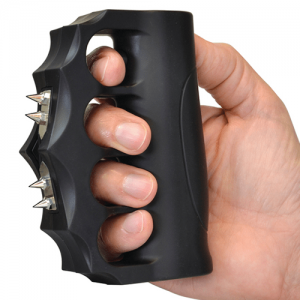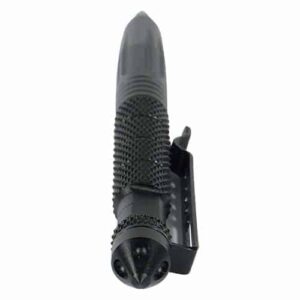Imagine a world where the pulse of a taser holds the power to change lives and protect communities. In this electrifying article, we explore the fascinating world of pulse tasers and their impact on law enforcement. From their innovative technology to their potential for reducing the use of lethal force, discover how these devices are revolutionizing the way we ensure public safety. Get ready to be charged with knowledge as we uncover the pulse of the taser.
Table of Contents
ToggleWhat is a Taser?
A Taser is a type of non-lethal weapon that is used to incapacitate a person temporarily through the use of electrical shocks. It is commonly used by law enforcement agencies as a means of subduing individuals without causing significant harm or resorting to lethal force.
Definition
A Taser, also known as a conducted electrical weapon (CEW), is a device that emits electrical pulses through two or more electrodes. These electrodes are typically attached to wires that propel them towards the target, allowing the electrical charge to make contact and deliver the shock. The Taser is designed to disrupt the voluntary control of muscles, causing temporary immobilization and incapacitation.
How does it work?
When a Taser is activated, it releases electrical pulses or shocks that interfere with the normal functioning of the nervous system. The electrical current travels through the body and disrupts the signals that control muscle movement. This leads to involuntary muscle contractions, rendering the person unable to move or resist.
The electrical pulses emitted by a Taser typically last for a few seconds, giving law enforcement officers a window of opportunity to restrain the individual safely. Unlike traditional stun guns, which require direct contact with the target, Tasers have the advantage of being able to immobilize targets from a distance.
Difference between a Taser and a stun gun
While both Tasers and stun guns are designed to incapacitate individuals using electrical shocks, they differ in how they deliver the electric current. A Taser uses projectiles that are propelled towards the target, allowing the electric charge to be delivered from a distance. On the other hand, a stun gun requires direct contact with the target to deliver the shock.
History of Tasers
Invention of the Taser
The Taser was invented by Jack Cover in the late 1960s. Initially named after a fictional weapon mentioned in a science fiction novel, the Taser was first developed as a handheld weapon that utilized gunpowder to propel its electrodes towards the target. This early design was primarily used by law enforcement agencies.
Development of Taser models
Over the years, the original Taser design underwent significant improvements and advancements. In the 1990s, model upgrades included the introduction of air cartridges and a multi-shot option. This allowed law enforcement officers to fire multiple shots without needing to reload, increasing their effectiveness and efficiency in the field.
As technology progressed, Taser models became more compact and lightweight, making them easier for law enforcement personnel to carry. The development of rechargeable batteries also eliminated the need for disposable batteries and reduced the overall cost of using Tasers.
Impact of Tasers on law enforcement
The introduction of Tasers revolutionized law enforcement tactics by providing officers with a non-lethal alternative to firearms. It offered them a way to safely subdue suspects without endangering their own lives or the lives of others.
Tasers quickly gained popularity within law enforcement agencies worldwide, with many departments adopting them as standard equipment. The use of Tasers in law enforcement became especially prevalent during situations where suspects were displaying aggressive behavior or resisting arrest. Their effectiveness in immobilizing individuals while minimizing the risk of serious injury or death made them a valuable tool for law enforcement officers.
Types of Tasers
Conducted Electrical Weapons (CEWs)
Conducted Electrical Weapons (CEWs) are the most common type of Tasers used by law enforcement agencies. They consist of a handheld device connected to electrodes through which the electrical current is delivered. CEWs are designed to be effective from a distance, allowing law enforcement officers to immobilize suspects without physical contact.
Wireless Electronic Control Devices (ECDs)
Wireless Electronic Control Devices (ECDs) are a type of Taser that do not require wired connections between the device and the electrodes. Instead, they utilize wireless technology to transmit the electrical charges. This allows for greater flexibility and maneuverability in tactical situations.
ECDs are often favored for their ease of use and portability. They provide law enforcement officers with a lighter and more compact alternative to traditional CEWs, without sacrificing effectiveness.
Specialized Tasers for law enforcement
In addition to the standard CEWs and ECDs, there are specialized Tasers designed specifically for law enforcement use. These may include features such as integrated laser sights for improved accuracy, extended range capabilities, or enhanced durability to withstand harsh environments.
Law enforcement agencies often have specific requirements and preferences when it comes to Tasers, and manufacturers have been quick to cater to these needs. Customization options allow agencies to select Tasers that align with their operational needs and budget constraints.
Legal and Ethical Considerations
Legal regulations for civilian use
The use of Tasers by civilians is regulated by laws that vary from country to country and even from state to state. In many jurisdictions, Tasers are classified as restricted weapons and can only be legally possessed and used with the appropriate permits or licenses. Some jurisdictions completely prohibit civilian use of Tasers.
It is important for individuals to familiarize themselves with the legal regulations regarding Tasers in their area before considering purchasing one. Failure to comply with these regulations can result in criminal charges and severe penalties.
Controversies surrounding law enforcement’s use of Tasers
The use of Tasers by law enforcement agencies has not been without controversy. Critics argue that the expanded use of Tasers has resulted in an increase in unnecessary force and harm. They raise concerns about the potential for abuse, as well as the disproportionate impact on marginalized communities.
There have been cases where the use of Tasers has resulted in injury, and in some instances, death. These incidents have raised questions about the appropriate circumstances for deploying Tasers and the training of law enforcement personnel in their use.
Potential risks and injuries of Tasers
While Tasers are designed to be non-lethal, they do carry certain risks. The electrical shocks delivered by Tasers can cause muscle contractions, which may lead to falls or other unintended injuries.
Additionally, individuals with certain medical conditions or who are under the influence of drugs or alcohol may be at a higher risk of experiencing adverse reactions to Taser deployments. These factors must be taken into consideration when determining whether to use a Taser and how to assess its potential impact on a person’s health.
Taser Effects on the Human Body
Physiological effects of Taser discharges
When a Taser is discharged, it affects the body in several ways. The electrical shock stimulates the sensory nerves, leading to intense pain and incapacitation. The sudden disruption of normal neural signaling causes the muscles to contract involuntarily, leading to temporary paralysis.
Impact on heart rate and cardiovascular system
The use of a Taser can also have an impact on the heart rate and cardiovascular system. Studies have shown that Taser discharges can cause an increase in heart rate, blood pressure, and levels of stress hormones. While these effects are generally temporary, individuals with pre-existing cardiac conditions may be more susceptible to adverse reactions.
It is important for law enforcement officers to be aware of any underlying health conditions that a person may have before deploying a Taser, as the potential for cardiac complications cannot be disregarded.
Neuromuscular incapacitation
One of the primary effects of Tasers is neuromuscular incapacitation. When the electrical pulses disrupt the nerve signaling to the muscles, it results in temporary paralysis. This effect allows law enforcement officers to safely apprehend individuals without resorting to more extreme measures.
The duration of neuromuscular incapacitation varies depending on several factors, including the location of the electrode placement, the duration of the Taser discharge, and the individual’s physical characteristics. In most cases, the effects of a Taser discharge wear off relatively quickly, allowing the person to regain control of their muscles.
Use of Tasers in Law Enforcement
Advantages of Tasers for law enforcement
Tasers have proven to be a valuable tool for law enforcement officers for several reasons. One major advantage is their ability to subdue suspects from a distance, minimizing the need for physical contact and reducing the risk of injury to both the officers and the individuals being apprehended.
Tasers are also highly effective at quickly incapacitating individuals, providing officers with a means of control in situations where verbal commands may have been ineffective. This can help de-escalate potentially dangerous encounters and prevent the need for higher levels of force.
Furthermore, the non-lethal nature of Tasers makes them a viable alternative to firearms in situations where lethal force may not be appropriate. Tasers provide law enforcement officers with a credible means of defense while minimizing the risk of fatal injuries.
Training protocols for Taser use
Law enforcement agencies recognize the importance of proper training in the use of Tasers. Training programs typically cover a range of topics, including understanding the physiological effects of Taser discharges, identifying appropriate use-of-force situations, and practicing proper targeting techniques.
The goal of training is to ensure that officers are proficient in the safe and effective use of Tasers, minimizing the risk of unnecessary harm to suspects while maintaining officer safety. It is crucial that officers receive ongoing training and refreshers to remain up-to-date on the latest techniques and best practices.
Evaluation of Taser effectiveness in reducing lethal force
Numerous studies have been conducted to evaluate the effectiveness of Tasers in reducing the use of lethal force by law enforcement officers. These studies have generally shown that the deployment of Tasers results in a decrease in injuries to both officers and suspects, as well as a reduction in officer-involved shootings.
Tasers have been credited with reducing the need for more lethal weapons in situations where individuals are non-compliant or displaying threatening behavior. The presence of Tasers in law enforcement agencies’ arsenal has been instrumental in providing officers with a less-lethal option that can help prevent unnecessary loss of life.
Studies and Research on Tasers
Academic studies on Taser usage
Academic researchers have conducted numerous studies on the usage of Tasers, both in law enforcement and civilian contexts. These studies have examined various aspects, including the physiological effects of Taser discharges, the impact on heart rate and cardiovascular health, and the effectiveness of Tasers in reducing injury rates.
The findings of these studies have greatly contributed to our understanding of the potential benefits and risks associated with Taser use. They have helped shape training protocols, inform policy discussions, and guide law enforcement practices.
Medical research on Taser effects
Medical professionals have also conducted research to better understand the potential medical implications of Taser use. Studies have examined the impact of Taser discharges on individuals with pre-existing health conditions, the potential for cardiac complications, and the long-term effects of repeated Taser deployments on overall health.
This research has led to improved guidelines for the deployment of Tasers and highlighted the importance of considering an individual’s medical history before using a Taser. It has also provided valuable information for medical professionals to better treat and assess individuals who have been subjected to Taser discharges.
Long-term health implications
The long-term health implications of Taser use continue to be an area of active research. While the immediate effects of Taser discharges are well-documented, less is known about any potential long-term health consequences.
Ongoing studies aim to examine the impact of repeated Taser deployments on cardiac health, neurological function, and overall well-being. This research will provide valuable insights into the potential risks associated with prolonged exposure to Taser discharges and inform future guidelines and policies.
Public Perception and Opinions
Factors influencing public opinion on Tasers
Public perception of Tasers is shaped by various factors, including media coverage, personal experiences, and social attitudes towards law enforcement. Media portrayal plays a significant role in shaping public opinion, as headlines highlighting controversial Taser incidents can influence how individuals perceive these devices.
Another factor is personal experience or witnessing Taser deployments. Positive experiences, where the use of a Taser may have prevented a more violent outcome, can contribute to a more favorable view of Tasers. Conversely, negative experiences or witnessing instances of excessive force can lead to skepticism or opposition towards their use.
Community reactions and protests
Instances of Taser deployments that result in injury or death can spark community reactions and protests. These incidents often attract public attention and may prompt calls for increased accountability and transparency in law enforcement practices.
Protest movements, such as Black Lives Matter, have drawn attention to the disproportionate impact of Tasers on marginalized communities. These movements advocate for comprehensive reforms in law enforcement policies, including stricter regulations on Taser usage and increased oversight to prevent abuses of power.
Public support or opposition towards Taser use
Public opinion on the use of Tasers by law enforcement is divided. Supporters argue that Tasers provide law enforcement officers with a valuable tool to protect themselves and others while minimizing the risk of fatal injuries. They believe that when used appropriately and in accordance with established protocols, Tasers can save lives.
Opponents, on the other hand, raise concerns about the potential for excessive force and abuse. They argue that Tasers can cause serious injuries or even fatalities, particularly when used on individuals with underlying health conditions or in situations involving the elderly or children.
Technological Innovations in Tasers
Advancements in Taser design and capabilities
Advancements in technology have led to significant innovations in Taser design and capabilities. Manufacturers continue to refine their products, making them more effective, reliable, and user-friendly.
Recent advancements include improved battery life, enhanced targeting systems for greater accuracy, and increased range capabilities. These developments not only improve the overall performance of Tasers but also provide law enforcement officers with the confidence and tools they need to safely respond to a wide range of situations.
Integration of body cameras with Tasers
The integration of body cameras with Tasers has become increasingly common in law enforcement. This combination allows for a comprehensive record of the encounter, capturing both audio and visual evidence of the Taser deployment.
By combining body camera footage with Taser activation data, law enforcement agencies can provide a more accurate and transparent account of incidents involving the use of Tasers. This integration promotes accountability, enhances training and evaluation processes, and aids in objective assessments of Taser deployments.
Future developments in non-lethal weaponry
As technology continues to advance, the future of non-lethal weaponry, including Tasers, looks promising. Manufacturers are actively exploring new innovations that can improve the effectiveness, efficiency, and safety of these devices.
Future developments may include advanced sensors and biometric feedback systems to provide real-time information on a target’s vital signs, enhanced targeting capabilities for pinpoint accuracy, and non-lethal alternatives to incapacitate individuals without relying solely on electrical shocks.
Conclusion
The Taser has undoubtedly had a significant impact on law enforcement practices and public safety. Its non-lethal nature and ability to quickly incapacitate individuals have made it an invaluable tool for law enforcement officers worldwide. Despite ongoing debates and controversies surrounding their use, Tasers continue to evolve, with training protocols and regulations helping to ensure their responsible and effective deployment.
While extensive research has been conducted on Tasers, there is still much to learn about their long-term effects and potential risks. Continued research in this field will contribute to the development of evidence-based guidelines and policies surrounding Taser use. As technology advances, future innovations in non-lethal weaponry have the potential to shape the landscape of law enforcement, providing officers with effective alternatives to lethal force while minimizing the risk of harm.













